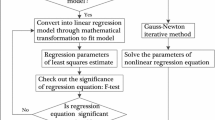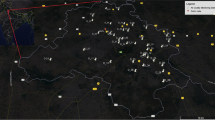Abstract
Missing data are very common in environmental monitoring activities. Traditional interpolation methods often view the problem from either spatial or temporal perspective and do not make good use of valuable related information, thereby leading to low prediction accuracy. Although many hybrid spatiotemporal interpolation methods combine temporal interpolation methods with spatial interpolation methods and show superiority over other single temporal or spatial interpolation methods, they do not finely treat each missing value in terms of its specific features. In this paper, two dynamic spatiotemporal interpolation (DST) methods, coarse-grained DST (CGDST) and fine-grained DST (FGDST) are proposed by using both temporal and spatial interpolation results. Different from other hybrid spatiotemporal interpolation methods, they create differences in the contribution of temporal and spatial interpolation results and assign them with different weights. Both CGDST and FGDST treat each missing value differently and fill it by considering the reliability of both temporal and spatial interpolation results in terms of the lengths of its column gap and row gap. CGDST treats each missing value in a continuous missing area equally and all missing values have the same lengths of column and row gaps. FGDST goes beyond CGDST and treats each missing value differently based on its temporal distance to the nearest real observed values in both forward and backward directions. To demonstrate their superiority, the experimental datasets were generated randomly to simulate missing values in real life. The results of the extensive experiments showed that FGDST improved by 2.44% \(\sim \) 8.21% in terms of symmetric mean absolute percentage error (SMAPE) compared with the best baseline method. Compared with CGDST, the improvements of FGDST range from 1.05% to 2.87% in terms of SMAPE. Moreover, their superiority is more obvious if there are more continuous missing values in the temporal dimension.













Similar content being viewed by others
References
Zhang Y, Zhang T, Li H (2021) Application of laser-induced breakdown spectroscopy (libs) in environmental monitoring. Spectrochim Acta B At Spectrosc 181:106218
Kamalanandhini M, Annadurai R (2021) Assessment of five meteorological indices for monitoring the drought condition in chengalpattu district, tamilnadu, india. Materials Today: Proceedings 46:3699–3703. International Conference on Materials, Manufacturing and Mechanical Engineering for Sustainable Developments-2020 (ICMSD 2020)
Campos PMD, Esteves AF, Leitão AA, Pires JCM (2021) Design of air quality monitoring network of luanda, angola: Urban air pollution assessment. Atmospheric Pollution Research 12(8):101128
Dsouza VL, Dsouza SF, Sarosh M, Kukkilaya S, Chilimbi V, Fernandes SR (2021) Remotely controlled boat for water quality monitoring and sampling. Materials Today: Proceedings
Bychkov S, Dolgal A, Simanov A (2021) Interpretation of Gravity Monitoring Data on Geotechnical Impact on the Geological Environment. Pure Appl Geophys 178(1):107–121
Trevathan J, Schmidtke S, Read W, Sharp T, Sattar A (2021) An iot general-purpose sensor board for enabling remote aquatic environmental monitoring. Internet of Things 16:100429
Shah J, Mishra B (2020) Iot-enabled low power environment monitoring system for prediction of pm2.5. Pervasive and Mobile Computing 67:101175
Dhamu V N, Banga I, Paul A, Ganguly A, Bhide A, Telang C, Muthukumar S, Prasad S (2021) Combinatorial sensors: An integrated approach to lifestyle management and environmental surveillance. In: Reference Module in Biomedical Sciences. Elsevier
Yi Z (2020) Discriminative dimensionality reduction for sensor drift compensation in electronic nose: A robust, low-rank, and sparse representation method. Expert Syst Appl 148:113238
Shi Q, Dai W, Santerre R, Liu N (2020) A Modified Spatiotemporal Mixed-Effects Model for Interpolating Missing Values in Spatiotemporal Observation Data Series. Math Probl Eng 2020:1–15
Terry WR, Lee JB, Kumar A (1986) Time series analysis in acid rain modeling: Evaluation of filling missing values by linear interpolation. Atmospheric Environment (1967) 20(10):1941–1943. First International Conference on Atmospheric Sciences and Applications to Air Quality Part II
Li K, Ding J, Chen Z (2020) Multi-point measurement stations and adjustment methods for mapping air temperatures of wuhan city, china. Build Environ 177:106910
Maleika W (2020) Inverse distance weighting method optimization in the process of digital terrain model creation based on data collected from a multibeam echosounder. Appl Geomatics 22(7):397–407
Indirawati S M, Pandia S, Mawengkang H, Hasan W (2017) Inverse distance weighted method and environmental health risks of plumbum pollution in drinking water in belawan coastal area. Adv Sci Lett 23(4):3339–3343
Kayikçi ET, Kazanci SZ (2016) Comparison of regression-based and combined versions of inverse distance weighted methods for spatial interpolation of daily mean temperature data. Arab J Geosci 9:10
Rojas-Gonzalez S, Van Nieuwenhuyse I (2020) A survey on kriging-based infill algorithms for multiobjective simulation optimization. Comput Oper Res 116:104869
Li Y, Wang L (2014) Research of spatiotemporal interpolation algorithm based on time series. Comput Sci 41(6A):414–424
Bo C, Shi Z, Zhao J (2021) Novel spatial and temporal interpolation algorithms based on extended field intensity model with applications for sparse aqi. Multimedia Tools and Applications
Ioannidis VN, Romero D, Giannakis GB (2018) Inference of spatio-temporal functions over graphs via multikernel kriged kalman filtering. IEEE Trans Signal Process 66(12):3228–3239
Wei J, Huang W, Li Z, Xue W, Peng Y, Sun L, Cribb M (2019) Estimating 1-km-resolution pm2.5 concentrations across china using the space-time random forest approach. Remote Sens Environ 231:111221
Hu H, Hu Z, Zhong K, Xu J, Zhang F, Zhao Y, Wu P (2019) Satellite-based high-resolution mapping of ground-level pm2.5 concentrations over east china using a spatiotemporal regression kriging model. Science of The Total Environment 672:479–490
Jiang T, Chen B, Nie Z, Ren Z, Xu B, Tang S (2021) Estimation of hourly full-coverage pm2.5 concentrations at 1-km resolution in china using a two-stage random forest model. Atmos Res 248:105146
Peng S (2010) Developments of spatio-temporal interpolation methods for meteorological elements. Master’s Thesis, Central South University
Cheng S, Peng P, Lu F (2020) A lightweight ensemble spatiotemporal interpolation model for geospatial data. Int J Geogr Inf Sci 34:1–24
Tong W, Li L, Zhou X, Hamilton A, Zhang K (2019) Deep learning pm2.5 concentrations with bidirectional lstm rnn. Air Quality, Atmosphere & Health 12:411–423
Feng Y, Xiang Y (2008) Mitigation of spectral mis-registration effects in imaging spectrometers via cubic spline interpolation. Opt Express 16(20):15366–15374
Baldi A, Bertolino F (2015) Experimental analysis of the errors due to polynomial interpolation in digital image correlation. Strain 51(3):248–263
Sun X (2005) Spatio-temporal process visualization for marine hydrological scale data. Master’s Thesis, Wuhan University
Schumann AH (1998) Thiessen polygonthiessen polygon. Springer Netherlands, Dordrecht, pp 648–649
Bartier P M, Keller CP (1996) Multivariate interpolation to incorporate thematic surface data using inverse distance weighting (idw). Comput Geosci 22(7):795–799
Webster R, Oliver MA (2007) Geostatistics for environmental scientists. John Wiley & Sons, Ltd
Nalder I A, Wein R W (1998) Spatial interpolation of climatic normals: test of a new method in the canadian boreal forest. Agric Forest Meteorol 92(4):211–225
Oliver MA, Webster R (1990) Kriging: a method of interpolation for geographical information systems. Int J Geogr Inf Syst 4(3):313–332
Bărbulescu A, Şerban C, Indrecan M-L (2021) Computing the beta parameter in idw interpolation by using a genetic algorithm. Water, 13(6),
Srivastava PK, Pandey PC, Petropoulos GP, Kourgialas NN, Pandey V, Singh U (2019) Gis and remote sensing aided information for soil moisture estimation: A comparative study of interpolation techniques. Resources, 8(2)
Hongxia W, Xiaoni L, Zhengchao R, Jingqiong W, Dongrong P, Jianjie H (2012) Spatial interpolation of precipitation - a case of gansu province. Grassland and turf 32(5):12–16
Ahmad AY, Saleh IA, Balakrishnan P, Al-Ghouti MA (2021) Comparison gis-based interpolation methods for mapping groundwater quality in the state of qatar. Groundwater for Sustainable Development 13:100573
Chen H, Fan L, Wu W, Liu H-B (2017) Comparison of spatial interpolation methods for soil moisture and its application for monitoring drought. Environmental Monitoring and Assessment 189(10):525
Bayen AM, Siauw T (2015) Chapter 14 - interpolation. In: Bayen AM, Siauw T (eds) An Introduction to MATLAB®;programming and numerical methods for engineers. Academic Press, Boston, pp 211–223
Goovaerts P (2000) Geostatistical approaches for incorporating elevation into the spatial interpolation of rainfall. J Hydrol 228(1):113–129
Hudson G, Wackernagel H (1994) Mapping temperature using kriging with external drift: Theory and an example from scotland. Int J Climatol 14(1):77–91
Bertino L, Evensen G, Wackernagel H (2002) Combining geostatistics and kalman filtering for data assimilation in an estuarine system. Inverse Methods, pp 1–23
Martínez WA, Melo CE, Melo OO (2017) Median polish kriging for space-time analysis of precipitation. Spatial Statistics 19:1–20
Xiao L, Christakos G, He J, Lang Y (2020) Space-time ground-level pm2.5 distribution at the yangtze river delta: A comparison of kriging, lur, and combined bme-lur techniques. Journal of Environmental Informatics 36:33–42
Zou Wy, Yin Sq, Wang Wt (2021) Spatial interpolation of the extreme hourly precipitation at different return levels in the haihe river basin. J Hydrol 598:126273
Wackernagel H (2003) Ordinary kriging. Springer, Berlin, Heidelberg, pp 79–88
Güler M (2014) A comparison of different interpolation methods using the geographical information system for the production of reference evapotranspiration maps in turkey. J Meteorol Soc Jpn 92:227–240
Wang X (2021) Historical data of air quality in China. https://quotsoft.net/air/, Accessed April 5, 2021
PyKrige (2021) Kriging toolkit for python. https://geostat-framework.readthedocs.io/projects/pykrige/en/latest/index.html, Accessed May 15, 2021
Inc. Facebook (2021) An open source machine learning framework that accelerates the path from research prototyping to production deployment. https://pytorch.org/, Accessed July 15, 2021
Tobler WR (1970) A computer movie simulating urban growth in the detroit region. Econ Geogr 46(sup1):234–240
Acknowledgements
This work is supported by the blue point distributed intelligent computing project of China University IUR Innovation Fund (Project No. 2021LDA12003), Natural Science Foundation of Gansu Province, China (Project No. 21JR7RA460), National College Students Innovation and Entrepreneurship Training Program (Project No. 202110730090) and National Natural Science Foundation of China (Project No. 61702240).
Author information
Authors and Affiliations
Corresponding author
Ethics declarations
Conflict of Interests
The authors declare that they have no conflicts of interest.
Additional information
Publisher’s note
Springer Nature remains neutral with regard to jurisdictional claims in published maps and institutional affiliations.
Shiping Gao and Dongjie He are contributed equally to this work.
Rights and permissions
About this article
Cite this article
Gao, S., He, D., Zhang, Z. et al. A novel dynamic interpolation method based on both temporal and spatial correlations. Appl Intell 53, 5100–5125 (2023). https://doi.org/10.1007/s10489-022-03815-7
Accepted:
Published:
Issue Date:
DOI: https://doi.org/10.1007/s10489-022-03815-7




